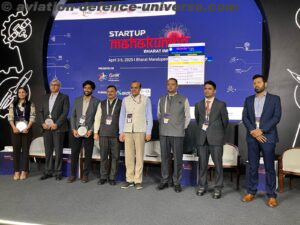- The consortium led by Thales Alenia Space signs the feasibility study contract with Italian Space Agency
New Delhi. 21 February 2022. Thales Alenia Space, the joint venture between Thales (67%) and Leonardo (33%), has signed a contract with the Italian space agency (ASI) to conduct a feasibility study for the PRISMA Second Generation(PSG) hyperspectral Earth observation system. It will be leading a consortium that includes Leonardo, Telespazio (the joint venture between Leonardo (67%) and Thales (33%)), e- GEOS and SITAEL.
Lasting nine months, the feasibility study will take an innovative approach to support the development of applications in both national and international markets, such as improved monitoring of natural and atmospheric resources, while providing the data needed to more effectively manage regional development and environmental risks.
The feasibility study will capitalize on increased interest in hyperspectral imaging by consolidating the technological excellence achieved through the PRISMA demonstration mission. It will deliver higher performance in line with the updated application requirements specified by the European Space Agency (ESA) for the upcoming Copernicus Hyperspectral Imaging Mission for the Environment (CHIME), deployed as part of Europe’s vast Copernicus environmental monitoring program.
The main challenge for hyperspectral technology is to capture images with high quality and spatial resolution, with frequent re-visit times and high signal to noise ratio. PRISMA SG will represent a significant step forward over the first-generation PRISMA system, improving spatial resolution via enhanced platform and instrument agility.
Thales Alenia Space in Italy will build the new satellite and take complete responsibility for system design, drawing on its proven experience in Earth observation satellites for Copernicus and the first and second- generation COSMO SkyMed satellites. It was also chosen by ESA in 2020 to design and build the two CHIME environmental monitoring satellites, with Leonardo contributing to the payload.
Leonardo provided the PRISMA hyperspectral instrument, already in orbit, and will also build this payload for PRISMA SG, but offering even higher performance to address the rapidly growing number of government, scientific and industrial applications.
Telespazio will be responsible for designing the PRISMA SG ground segment, while e-GEOS, a joint Telespazio (80%) and ASI (20%) company, will be in charge of market analysis and will also help Leonardo define user requirements.
SITAEL, a space company and a part of Angel Group, capitalizing on the national investments on electric propulsion, will participate in the trade-offs of satellite and platform as well as study the configurations to make PRISMA SG an “all-electric” satellite, thus ensuring the maneuverability and operational flexibility that only this type of satellites provide. Moreover, thanks to its extensive experience in control electronics, as in the case of the ESA Copernicus CHIME mission, SITAEL will study the sophisticated control unit of the hyperspectral payload, aiming at the scalability of a cutting-edge and consolidated technology that is able to speed up the development time as well as the implementation costs.

































































































































